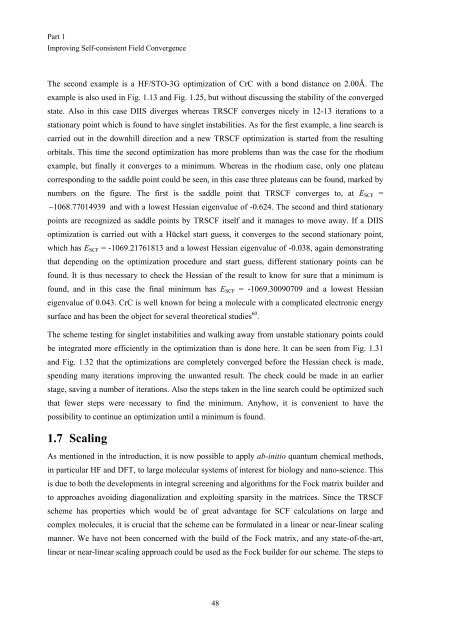Get my PhD Thesis
Get my PhD Thesis
Get my PhD Thesis
Create successful ePaper yourself
Turn your PDF publications into a flip-book with our unique Google optimized e-Paper software.
Part 1<br />
Improving Self-consistent Field Convergence<br />
The second example is a HF/STO-3G optimization of CrC with a bond distance on 2.00Å. The<br />
example is also used in Fig. 1.13 and Fig. 1.25, but without discussing the stability of the converged<br />
state. Also in this case DIIS diverges whereas TRSCF converges nicely in 12-13 iterations to a<br />
stationary point which is found to have singlet instabilities. As for the first example, a line search is<br />
carried out in the downhill direction and a new TRSCF optimization is started from the resulting<br />
orbitals. This time the second optimization has more problems than was the case for the rhodium<br />
example, but finally it converges to a minimum. Whereas in the rhodium case, only one plateau<br />
corresponding to the saddle point could be seen, in this case three plateaus can be found, marked by<br />
numbers on the figure. The first is the saddle point that TRSCF converges to, at E SCF =<br />
− 1068.77014939 and with a lowest Hessian eigenvalue of -0.624. The second and third stationary<br />
points are recognized as saddle points by TRSCF itself and it manages to move away. If a DIIS<br />
optimization is carried out with a Hückel start guess, it converges to the second stationary point,<br />
which has E SCF = -1069.21761813 and a lowest Hessian eigenvalue of -0.038, again demonstrating<br />
that depending on the optimization procedure and start guess, different stationary points can be<br />
found. It is thus necessary to check the Hessian of the result to know for sure that a minimum is<br />
found, and in this case the final minimum has E SCF = -1069.30090709 and a lowest Hessian<br />
eigenvalue of 0.043. CrC is well known for being a molecule with a complicated electronic energy<br />
surface and has been the object for several theoretical studies 60 .<br />
The scheme testing for singlet instabilities and walking away from unstable stationary points could<br />
be integrated more efficiently in the optimization than is done here. It can be seen from Fig. 1.31<br />
and Fig. 1.32 that the optimizations are completely converged before the Hessian check is made,<br />
spending many iterations improving the unwanted result. The check could be made in an earlier<br />
stage, saving a number of iterations. Also the steps taken in the line search could be optimized such<br />
that fewer steps were necessary to find the minimum. Anyhow, it is convenient to have the<br />
possibility to continue an optimization until a minimum is found.<br />
1.7 Scaling<br />
As mentioned in the introduction, it is now possible to apply ab-initio quantum chemical methods,<br />
in particular HF and DFT, to large molecular systems of interest for biology and nano-science. This<br />
is due to both the developments in integral screening and algorithms for the Fock matrix builder and<br />
to approaches avoiding diagonalization and exploiting sparsity in the matrices. Since the TRSCF<br />
scheme has properties which would be of great advantage for SCF calculations on large and<br />
complex molecules, it is crucial that the scheme can be formulated in a linear or near-linear scaling<br />
manner. We have not been concerned with the build of the Fock matrix, and any state-of-the-art,<br />
linear or near-linear scaling approach could be used as the Fock builder for our scheme. The steps to<br />
48

















